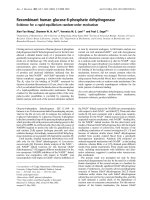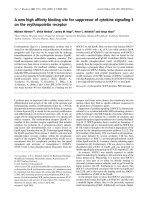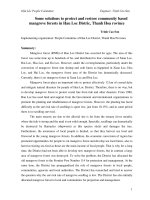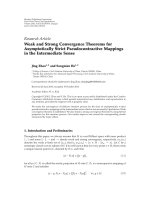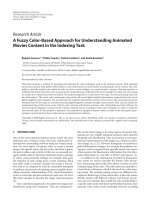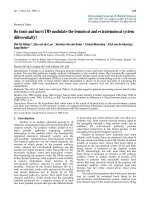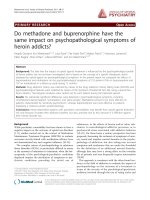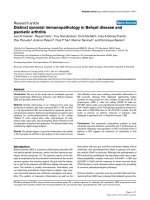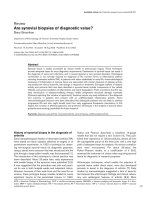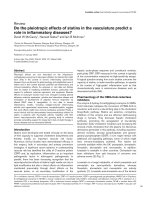Báo cáo y học: "Do synovial biopsies help to support evidence for involvement of innate immunity in the immunopathology of Behçet’s disease" pot
Bạn đang xem bản rút gọn của tài liệu. Xem và tải ngay bản đầy đủ của tài liệu tại đây (50.54 KB, 3 trang )
Available online />Page 1 of 3
(page number not for citation purposes)
Abstract
Behçet’s disease is a complex vasculitis of unknown etiology.
Abundant neutrophils suggest the involvement of innate immunity.
Cytokines are skewed to the T-helper-1 pattern. Few sterile organs
are easily accessible for analysis in Behçet’s disease. Cañete and
coworkers identify inflamed joints as a feasible model and suggest
the involvement of innate immunity in Behçet’s disease.
In a recent issue of Arthritis Research and Therapy, Cañete
and coworkers [1] describe a model for studying the immuno-
pathology of Behçet’s disease (BD) by analyzing inflammatory
cells, tissue, and cytokines in inflamed joints from BD
patients. The etiology of BD is obscure but it is considered to
be a complex systemic vasculitis, caused by T-helper-1 (Th1)
cytokine skewed neutrophilic and lymphohistiocytic inflam-
mation. Hence, an understanding of how cells and cytokines
function in inflamed tissues is important in terms of develop-
ing therapeutic interventions [2]. A good example of how
mechanistic insight can lead to effective treatment is that BD
disease symptoms can be effectively and rapidly reduced by
blocking tumor necrosis factor (TNF)-α, a key cytokine in BD
[3]. Activation of BD can be triggered by exogenous factors
such as skin damage, introduction of bacterial components,
viruses and stress subsequently leading to inflammation [4].
A normal inflammatory response is rapid, non-specific, and
self-limiting. It involves a carefully balanced reaction between
activated inflammatory cells and an exogenous trigger. In
inflammatory disorders such as BD, this response is
unbalanced and causes excessive damage to the host. The
association of human leukocyte antigen (HLA)-B51 with BD
and hyperactive neutrophils stresses the importance of innate
immunity in the pathogenesis of the disease [5]. Other factors
supporting participation of the innate immune system in BD
include the following: prevalence of symptoms in body sites
in close contact with the outside environment (skin and
mucosa); the presence of hypersensitive T cells; Toll-like
receptor expression in affected cells; and hyperactive
neutrophilic and CD8
+
T-cell responses to heat shock
proteins or bacterial cell wall fragments [2,4]. Cytokines that
are involved in BD are largely pro-inflammatory (IL-1β, IL-8, IL-
10, TNF-α, and IFN-γ). Peripheral T cells in BD patients
predominantly exhibit a Th1-type pattern of cytokine
expression [6].
How does the study of Cañete and coworkers [1] add to the
biomechanistic studies that have already been conducted in
BD? First, in contrast to most of those studies, the analyses
by Cañete and coworkers were conducted in untreated
patients. In an uncommon disease such as BD, few studies in
naïve patients are reported. In rheumatoid arthritis (RA), for
example, early and aggressive treatment is considered
mandatory if an optimal therapeutic outcome is to be
achieved. It will therefore be of great therapeutic importance
to identify possible initiating factors in BD also by testing
therapy-naïve patients. This is especially important for the
irreversible ophthalmic manifestations of the disease.
Second, it is important that representative tissue is studied. In
BD most mechanistic studies are conducted in blood
samples; predominantly, testing of circulating cytokines or in
vitro peripheral blood mononuclear cells is done. Th1
cytokines are involved, and hyperactive neutrophils and
hyper-reactive T cells are held responsible for the symptoms
observed [7]. However, BD is an inflammatory disorder
involving tissues such as skin, joint, eye, gut, brain, and oral
and genital mucosa [2,4]. It is therefore mandatory to be sure
that observations in blood are representative of bio-
mechanisms at the tissue level.
Editorial
Do synovial biopsies help to support evidence for involvement of
innate immunity in the immunopathology of Behçet’s disease?
Jan AM van Laar, Jasper H Kappen, Paul LA van Daele and P Martin van Hagen
Department of Internal Medicine, Section of Clinical Immunology & Department of Immunology, Erasmus University Medical Center, PO Box 2040,
3000 CA Rotterdam, The Netherlands
Corresponding author: Jan AM van Laar,
Published: 30 April 2009 Arthritis Research & Therapy 2009, 11:109 (doi:10.1186/ar2657)
This article is online at />© 2009 BioMed Central Ltd
See related research article by Cañete et al., />BD = Behçet’s disease; HLA = human leukocyte antigen; IFN = interferon; IL = interleukin; RA = rheumatoid arthritis; SF = synovial fluid; SpA =
spondyloarthropathy; SPR = skin pathergy reaction; Th1 = T-helper-1.
Arthritis Research & Therapy Vol 11 No 2 van Laar et al.
Page 2 of 3
(page number not for citation purposes)
Mucosal tissue is predominantly involved in BD, and micro-
organisms from the external environment can readily influence
observations in inflammatory cells. On the other hand, those
micro-organisms are also capable of stimulating an immune
response in BD. Most tissue studies of the pathophysiology
of BD are conducted in skin. One of the unique and disease-
specific features of BD is the occurrence of a positive skin
pathergy reaction (SPR), which is observed in 30% to 75%
of all BD patients [2,4]. Neutrophils and subsequently
lymphohistiocytic cells may be observed in sterile lesions
following a sterile needle prick [8]. Representing endothelial
injury and functioning as leukocyte trafficking factors, cell
adhesion molecules (intercellular adhesion molecule-1 and
vascular cell adhesion molecule-1) and endothelial growth
factor markers such as E-selectin, P-selectin, and endoglin
are linked to SPR [9]. Infiltrating cells are mainly of the
HLA-DR
+
/CD3
+
/CD4
+
/CD45RO
+
type [10]. Other observa-
tions include mature dendritic cells; monocytes; (regulatory)
T cells; elevated levels of IFN-γ, IL-12-p40 and IL-15; MIP3-α
(macrophage inflammatory protein-3α); IP-10 (IFN-inducible
protein-10); Mig (monokine induced by IFN-γ); iTac
(interferon-inducible T cell chemo-attractant); and adhesion
molecules [11].
Studies of ocular BD show elevated Vγ9Vδ2 (CD4
-
/CD8
-
)
and CD8
bright
CD56
+
T cells, which are probably different
from those found infiltrating the SPR [12]. Cytokines found to
be elevated in ocular fluid from BD patients with active uveitis
include IFN-γ, TNF-α, and IL-15 [13]. It must be stressed,
however, that aqueous humor is seldom studied because it is
difficult to obtain samples; it is only evaluated in intensively
and chronically treated BD patients.
In contrast to most of the inflamed organs in BD, the joint is
sterile and frequently involved in BD. Cañete and coworkers
exploit this readily accessible model, which has not often
been studied in BD. Studies of BD arthropathy dating back
more than 30 years predominantly revealed neutrophillic infil-
tration, depending on the stage and treatment of the disease.
A more recent study of synovial fluid (SF) from BD patients
identified increased levels of chemokines (C-X-C chemokine
ligand-9 and -10) related to Th1-directed inflammation [14].
Cañete’s group has studied SF extensively in various other
arthropathies, such as spondyloarthropathy (SpA) and RA,
and comparisons may be made with historical data.
Comparing SF samples between SpA and other rheumatic
diseases (RA, juvenile SpA, juvenile polyarthritis, and juvenile
oligoarthritis) revealed similarities only in terms of the
presence of CD3
+
, CD4
+
, and CD8
+
cells [15].
In the study presented Cañete and coworkers [1] conclude
that psoriatic arthritis (PsA) resembles BD clinically; a further
similarity is the presence of neutrophils in SF from PsA
patients. Increased levels of intra-articular CD15
+
neutrophils,
CD3
+
T cells, and perforin were identified in SF from active
BD patients relative to SF from patients with PsA. This
emphasizes that innate immunity is also involved in early BD
and interacts with adaptive immunity, as reflected by the
presence of perforin, presumably secreted by CD3
+
T cells. It
might therefore be of interest to conduct further studies of
these naïve T cells and cytokines in sterile SF in order to
relate these observations to immunological patterns that have
already been described in tissues that are exposed to
exogenous factors, or more intensively treated BD patients.
These results can then be compared with various other
inflammatory diseases in order to obtain greater insight into
the immune-related etiology of BD and to develop more
specific, molecular based immunotherapies. Examples may
include targeting cytokines (IL-1, IL-10, or IL-6) and use of
agents that interfere with lymphocyte action.
Competing interests
The authors declare that they have no competing interests.
Authors’ information
The authors of this editorial include a PhD resident (JK) and
internist-immunologists (JVL, PVD, and PVH), representing
the staff of the clinical immunological section of the internal
medicine department of the largest Dutch university hospital.
Their work concentrates on (auto)immune diseases and
immune deficiencies. An outpatient population of more than
110 BD patients represents the largest Dutch population and
provides a basis for both immunopathophysiologic, genetic,
and therapeutic studies and reports.
References
1 Cañete JD, Celis R, Noordenbos T, Moll C, Gómez-Puerta JA,
Pizcueta P, Palacin A, Tak PP, Sanmartí R, Baeten D: Distinct
synovial immunopathology in Behçet disease and psoriatic
arthritis. Arthritis Res Ther 2009, 11:R17.
2 Sakane T, Takeno M, Suzuki N, Inaba G: Behçet’s disease. N
Engl J Med 1999, 341:1284-1291.
3 van Laar JA, Missotten T, van Daele PL, Jamnitski A, Baarsma GS,
van Hagen PM: Adalimumab: a new modality for Behçet’s
disease? Ann Rheum Dis 2007, 66:565-566.
4 Yazici H, Fresko I, Yurdakul S: Behçet’s syndrome: disease
manifestations, management, and advances in treatment. Nat
Clin Pract Rheumatol 2007, 3:148-155.
5 Takeno M, Kariyone A, Yamashita N, Takiguchi M, Mizushima Y,
Kaneoka H, Sakane T: Excessive function of peripheral blood
neutrophils from patients with Behçet’s disease and from
HLA-B51 transgenic mice. Arthritis Rheum 1995, 38:426-433.
6 Suzuki N, Nara K, Suzuki T: Skewed Th1 responses caused by
excessive expression of Txk, a member of the Tec family of
tyrosine kinases, in patients with Behcet’s disease. Clin Med
Res 2006, 4:147-151.
7 Accardo-Palumbo A, Triolo G, Carbone MC, Ferrante A, Ciccia F,
Giardina E, Triolo G: Polymorphonuclear leukocyte myeloper-
oxidase levels in patients with Behçet’s disease. Clin Exp
Rheumatol 2000, 18:495-498.
8 Ergun T, Gürbüz O, Harvell J, Jorizzo J, White W: The
histopathology of pathergy: a chronologic study of skin hyper-
reactivity in Behçet’s disease. Int J Dermatol 1998, 37:929-
933.
9 Inaloz HS, Evereklioglu C, Unal B, Kirtak N, Eralp A, Inaloz SS:
The significance of immunohistochemistry in the skin
pathergy reaction of patients with Behçet’s syndrome. J Eur
Acad Dermatol Venereol 2004, 18:56-61.
10 Gül A, Esin S, Dilsen N, Koniçe M, Wigzell H, Biberfeld P:
Immunohistology of skin pathergy reaction in Behçet’s
disease. Br J Dermatol 1995, 132:901-907.
11 Melikoglu M, Uysal S, Krueger JG, Kaplan G, Gogus F, Yazici H,
Oliver S: Characterization of the divergent wound-healing
responses occurring in the pathergy reaction and normal
healthy volunteers. J Immunol 2006, 177:6415-6421.
12 Verjans GM, van Hagen PM, van der Kooi A, Osterhaus AD,
Baarsma GS: Vgamma9Vdelta2 T cells recovered from eyes of
patients with Behçet’s disease recognize non-peptide prenyl
pyrophosphate antigens. J Neuroimmunol 2002, 130:46-54.
13 Ahn JK, Yu HG, Chung H, Park YG. Intraocular cytokine envi-
ronment in active Behçet uveitis. Am J Ophthalmol 2006, 142:
429-434.
14 Erdem H, Pay S, Musabak U, Simsek I, Dinc A, Pekel A, Sengul A:
Synovial angiostatic non-ELR CXC chemokines in inflamma-
tory arthritides: does CXCL4 designate chronicity of synovi-
tis? Rheumatol Int 2007, 27:969-973.
15 Kruithof E, Van den Bossche V, De Rycke L, Vandooren B, Joos R,
Cañete JD, Tak PP, Boots AM, Veys EM, Baeten D: Distinct syn-
ovial immunopathologic characteristics of juvenile-onset
spondylarthritis and other forms of juvenile idiopathic arthri-
tis. Arthritis Rheum 2006, 54:2594-2604.
Available online />Page 3 of 3
(page number not for citation purposes)
